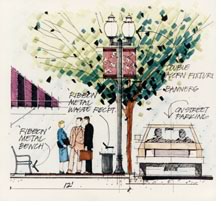
by Daniel R. Atilano, AIA
 Two
years ago, we were determined to increase the name recognition of Burnidge
Cassell Associates (BCA). I had been at a seminar put on by firm-management
consultant ZweigWhite Associates at which they suggested that we step
away from the typical architecture firm newsletter and try something more
client-focused.
Two
years ago, we were determined to increase the name recognition of Burnidge
Cassell Associates (BCA). I had been at a seminar put on by firm-management
consultant ZweigWhite Associates at which they suggested that we step
away from the typical architecture firm newsletter and try something more
client-focused.
As part of our overall marketing strategy, we had been putting out a quarterly newsletter for about two years at that point. It touted what we were doing and highlighted our most recent projects. I'm sure you've seen these—you may be doing one yourself. What we decided to try instead was a monthly offering of news-you-can-use. Articles, written by our in-house topic experts, focus on our surveys and other research on trends and innovations that we feel will interest and benefit our clients.
The BCA Memo has been very well received. Our mailing list, which we had already developed for our other mailings, includes clients, potential clients, and other people of influence. We haven't yet done a formal survey of our readership, but we do get people coming up to us at the trade shows at which we exhibit (another arm of our marketing strategy) to tell us that they really enjoy getting our publication. They look forward to it. And they thank us. Not only is that a good conversation starter, it is evidence that we are effectively establishing our name among potential clients in our specific markets. We have developed a way to get onto our target audiences' radar screens and give them some appreciation of the value we bring to the table.
 Another
benefit we've derived from the BCA Memo is that we're getting more RFQs
coming in that are tailored to what people know that we do. Before, we'd
get RFQs across the board, including areas that aren't one of our specialties
and that we're not interested in pursuing. So the newsletter lets people
know with some specificity what areas of knowledge we're able to provide,
and, as a side benefit, our prospects become more focused.
Another
benefit we've derived from the BCA Memo is that we're getting more RFQs
coming in that are tailored to what people know that we do. Before, we'd
get RFQs across the board, including areas that aren't one of our specialties
and that we're not interested in pursuing. So the newsletter lets people
know with some specificity what areas of knowledge we're able to provide,
and, as a side benefit, our prospects become more focused.
Besides exhibiting at trade shows and the BCA Memo, we also get our name out through speaking engagements. Once again, this is something we can reinforce with the monthly newsletter. By tying a particular topic to an upcoming conference, we reinforce that we are recognized topic experts. The monthly format also allows us to let people know in a timely way of our recent achievements and upcoming events they might want to attend. Clients feel more engaged with us, and our staff get a boost by being recognized and knowing their contributions are appreciated.
The newsletter is a key element of our Web site as well. By posting past issues of the newsletter, we have accumulated a catalog of quick and informative glimpses into what the firm is about in all four of our markets: education, libraries, recreation, and municipal work. We post them in PDF so that they will print out looking as intended.
How it works
As I noted, we already had a mailing list based on the markets that we're
after. We decided to send every newsletter to the entire list. Other than
staff time, the largest expenditure is for mailing—about $300 to
$500 per issue. We have the in-house capability to design and print the
publication. Although the writing of articles is rotated among staff,
we also have one person, Jill Johnson, dedicated to producing the newsletter,
getting it onto the Web site, and responding to email, among many other
responsibilities.
 We
also decided to keep the articles relatively short—one side of an
8-1/2 x 11-inch sheet, which folds into a self-mailer. By keeping the
articles to about 725 words, with illustrations, subheads, and callouts,
the feature story is more likely to be read. We also three-hole punch
the sheet, both for convenience and for the underlying message that this
is material the recipient will want to file. There is an art to information
presentation.
We
also decided to keep the articles relatively short—one side of an
8-1/2 x 11-inch sheet, which folds into a self-mailer. By keeping the
articles to about 725 words, with illustrations, subheads, and callouts,
the feature story is more likely to be read. We also three-hole punch
the sheet, both for convenience and for the underlying message that this
is material the recipient will want to file. There is an art to information
presentation.
We devote one of the three panels on the back of the folded issue to "What's new at BCA?," a feature that allows us—in bulleted format—to mention the recent successes of each of our studios, upcoming speaking engagements, and additions to our knowledge base. The middle back panel is devoted to the recipient's address (with our logo prominent in the return address). On the third back panel, we repeat the logo along with more detailed contact information and our client-service goal statement.
With 35 people in four studios, we have the luxury of spreading out the article assignments among our professional staff. I come up with a yearly calendar of article topics for each month, what studio each article will fall into, and who the contributor will be. There can be some flexibility if something unanticipated comes up, but the yearly assignment has worked fairly well. I try to have each studio produce at least two articles per year so that our work can get exposure across the board.
Typically, I'll put the responsibility for writing an article on the studio team leader. If that person doesn't write it, he or she has to get somebody within that studio to write it. Sometimes things will come up, people get busy, and I'll get a near-deadline call, "Sorry Daniel, I just don't have the time." And guess who gets to write it. I do. That's an area where we could use some refinement, and something I'm going to try to suggest we change after the business planning for next year.
 I
should stress here the importance of adhering to a strict set of deadlines.
Readers do come to look forward to getting their BCA Memo. Although our
readers most likely wouldn't notice a slip of a week—or maybe even
missing a whole month—that kind of inattention to scheduling would
send a bad subliminal message, as would any gaps in our back issues posted
on the Web.
I
should stress here the importance of adhering to a strict set of deadlines.
Readers do come to look forward to getting their BCA Memo. Although our
readers most likely wouldn't notice a slip of a week—or maybe even
missing a whole month—that kind of inattention to scheduling would
send a bad subliminal message, as would any gaps in our back issues posted
on the Web.
Just one tool in the shed
Although BCA Memo is a very important tool in our marketing effort, it
is only one of many that we continue to develop. Trade show attendance
is also up there, and we've recently increased both the number of trade
shows and conferences at which we exhibit and the size of our booth (up
to 10x20 from the more typical 10x10), which allows us to create more
presence. Last year we also mailed six different postcards. Each of the
oversized postcards featured an image of a significant project on the
front and a brief message on the back telling people a little about the
project. We probably spend what the typical firm does on our marketing
(about 7.5 percent, according to the AIA
Firm Survey) or maybe a little more. What makes our initiatives
effective is the effort we put into planning and coordinating the various
parts of our marketing.
Our attitude is: If you're going to increase firm growth and profit, you've got to invest more in your future. We're finding it's paying us back in dividends.
Copyright 2002 The American Institute of Architects. All rights reserved.
![]()
|
Daniel Atilano is a principal of Burnidge Cassell Associates and past president of AIA Northeast Illinois. |
|